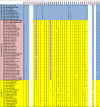Parenteral viral hepatitis among students in Da Nang, Vietnam, and insights into new hepatitis B virus genotype B classification
- PMID: 40594411
- PMCID: PMC12218278
- DOI: 10.1038/s41598-025-05409-y
Parenteral viral hepatitis among students in Da Nang, Vietnam, and insights into new hepatitis B virus genotype B classification
Abstract
This cross-sectional study estimated the prevalence of hepatitis B, C, D viruses among adults aged 18-22 years and assessed the impact of viral populations on the epidemiological trends in hepatitis virus transmission. A total of 568 students of Da Nang University were enrolled in the study in 2018. The prevalence of HBsAg, anti-HBs and anti-HBc was 4.2% (24/568), 30.4% (173/568), and 17.6% (100/568), respectively. Anti-HCV was found in 0.2% (1/568) of samples, and no participants tested positive for anti-HDV. HBV DNA was detected in all HBsAg-positive samples: 19 HBV isolates belonged to genotype B, and 5-to genotype C. Eight isolates carried immune escape mutations within the S protein, and one harbored three mutations (1762A > T / 1764G > A, 1858 T > C) in the precore/core region. Most of HBV isolates belonged to subgenotype B4, which is part of the Ba global recombinant group comprising subgenotypes B2, B4 and "quasi-B3", characterized by common recombination sites between positions 1731-1846 and 2200-2252. These findings highlight the high prevalence of HBV and insufficient herd immunity against HBV within this cohort, underscoring the urgent need to expand national HBV vaccination strategies. Widespread distribution of the Ba global recombinant group emphasizes the necessity to revise the current HBV taxonomy.
Keywords: Adult aged 18–22 years; HBV / genetic diversity / classification; HCV; HDV; Prevalence; Vietnam.
© 2025. The Author(s).
Conflict of interest statement
Declarations. Competing interests: The authors declare no competing interests.
Figures



Similar articles
-
Molecular characteristics of hepatitis B virus among students and pregnant women in Chad.BMC Infect Dis. 2025 Jul 1;25(1):863. doi: 10.1186/s12879-025-11226-5. BMC Infect Dis. 2025. PMID: 40597040 Free PMC article.
-
Evolutionary Insights of Hepatitis B Virus Genotypes and Profiles of Mutations in Surface and Basal Core Promoter/Pre-Core Genes Among HBsAg-Positive Patients in North-Central and Southwestern Nigeria.Viruses. 2025 Aug 10;17(8):1101. doi: 10.3390/v17081101. Viruses. 2025. PMID: 40872815 Free PMC article.
-
[Investigation of Infection in HBV-Reactive Blood Donors in Wuhan].Zhongguo Shi Yan Xue Ye Xue Za Zhi. 2025 Jun;33(3):875-880. doi: 10.19746/j.cnki.issn.1009-2137.2025.03.038. Zhongguo Shi Yan Xue Ye Xue Za Zhi. 2025. PMID: 40613185 Chinese.
-
Hepatitis B immunoglobulin during pregnancy for prevention of mother-to-child transmission of hepatitis B virus.Cochrane Database Syst Rev. 2017 Feb 11;2(2):CD008545. doi: 10.1002/14651858.CD008545.pub2. Cochrane Database Syst Rev. 2017. PMID: 28188612 Free PMC article.
-
Epidemiology of hepatitis B, C and D in Malawi: systematic review.BMC Infect Dis. 2018 Oct 12;18(1):516. doi: 10.1186/s12879-018-3428-7. BMC Infect Dis. 2018. PMID: 30314448 Free PMC article.
References
-
- Publication Item. https://www.who.int/publications/i/item/9789240091672.
-
- Ou, T.-Y. et al. Global mortality of chronic liver diseases attributable to hepatitis B virus and hepatitis C virus infections from 1990 to 2019 and projections to 2030. J. Infect Public Health17, 102443 (2024). - PubMed
-
- Cooke, G. S. et al. Accelerating the elimination of viral hepatitis: a lancet gastroenterology & hepatology commission. Lancet Gastroenterol. Hepatol.4, 135–184 (2019). - PubMed
MeSH terms
Substances
LinkOut - more resources
Full Text Sources
Medical

